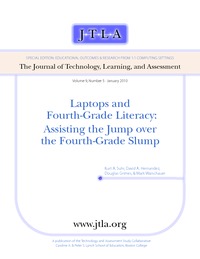Laptops and Fourth Grade LiteracyAssisting the Jump over the Fourth-Grade Slump
Publikationsdatum:
|
 |
 Diese Seite wurde seit 2 Jahren inhaltlich nicht mehr aktualisiert.
Unter Umständen ist sie nicht mehr aktuell.
Diese Seite wurde seit 2 Jahren inhaltlich nicht mehr aktualisiert.
Unter Umständen ist sie nicht mehr aktuell.
 Zusammenfassungen
Zusammenfassungen
 School districts throughout the country are considering how to best integrate technology into instruction. There has been a movement in many districts toward one-to-one laptop instruction, in which all students are provided a laptop computer, but there is concern that these programs may not yield sufficiently improved learning outcomes to justify their substantial cost. And while there has been a great deal of research on the use of laptops in schools, there is little quantitative research systematically investigating the impact of laptop use on test outcomes, and none among students at the fourth-to-fifth grade levels. This study investigated whether a one-to-one laptop program could help improve English language arts (ELA) test scores of upper elementary students, a group that often faces a slowdown of literacy development during the transition from learning to read to reading to learn known as the fourth-grade slump.
School districts throughout the country are considering how to best integrate technology into instruction. There has been a movement in many districts toward one-to-one laptop instruction, in which all students are provided a laptop computer, but there is concern that these programs may not yield sufficiently improved learning outcomes to justify their substantial cost. And while there has been a great deal of research on the use of laptops in schools, there is little quantitative research systematically investigating the impact of laptop use on test outcomes, and none among students at the fourth-to-fifth grade levels. This study investigated whether a one-to-one laptop program could help improve English language arts (ELA) test scores of upper elementary students, a group that often faces a slowdown of literacy development during the transition from learning to read to reading to learn known as the fourth-grade slump.
We explore these questions by comparing changes in the ELA test scores of a group of students who entered a one-to-one laptop program in the fourth grade to a similar group of students in a traditional program in the same school district. After two years’ participation in the program, laptop students outperformed non-laptop students on changes in the ELA total score and in the three subtests that correspond most closely to frequent laptop use: writing strategies, literary response and analysis, and reading comprehension.
 Dieser Zeitschriftenartikel erwähnt ...
Dieser Zeitschriftenartikel erwähnt ...
 Begriffe KB IB clear | Ein Notebook pro StudentIn (ENpS)
, One-to-One-ComputingOne-to-One-Computing
,  Problemlösefähigkeit Problemlösefähigkeit problem solving skills
, problem solving skills
,  Schule Schule school school
|
 Dieser Zeitschriftenartikel erwähnt vermutlich nicht ...
Dieser Zeitschriftenartikel erwähnt vermutlich nicht ... 
 Nicht erwähnte Begriffe | LehrerIn, Notebook, Notebooks an Schulen, Unterricht |
 Tagcloud
Tagcloud
 Zitationsgraph
Zitationsgraph
 Zitationsgraph (Beta-Test mit vis.js)
Zitationsgraph (Beta-Test mit vis.js)
 5 Erwähnungen
5 Erwähnungen 
- New Technology and Digital Worlds - Analyzing Evidence of Equity in Access, Use, and Outcomes (2010)


- Can One Latop Per Child Save The World's Poor? (Mark Warschauer, Morgan Ames) (2010)


- 2. Workshop «Lerninfrastruktur in Schulen: 1:1-Computing» (Richard Heinen, Andreas Breiter, Beat Döbeli Honegger, Michael Kerres, Renate Schulz-Zander, Joachim Wedekind, Stefan Welling) (2011)


- DeLFI 2011 - Workshopband (Holger Rohland, Andrea Kienle, Steffen Friedrich) (2011)


- One Laptop per Child Birmingham - Case Study of a Radical Experiment (Mark Warschauer, Shelia R. Cotten, Morgan Ames) (2012)


 Volltext dieses Dokuments
Volltext dieses Dokuments
 |  Laptops and Fourth Grade Literacy: Artikel als Volltext ( Laptops and Fourth Grade Literacy: Artikel als Volltext ( : :  , 336 kByte; , 336 kByte;  : :  Link unterbrochen? Letzte Überprüfung: 2020-11-28 Letzte erfolgreiche Überprüfung: 2019-01-28) Link unterbrochen? Letzte Überprüfung: 2020-11-28 Letzte erfolgreiche Überprüfung: 2019-01-28) |
 Anderswo suchen
Anderswo suchen 
 Beat und dieser Zeitschriftenartikel
Beat und dieser Zeitschriftenartikel
Beat hat Dieser Zeitschriftenartikel während seiner Zeit am Institut für Medien und Schule (IMS) ins Biblionetz aufgenommen. Beat besitzt kein physisches, aber ein digitales Exemplar. Eine digitale Version ist auf dem Internet verfügbar (s.o.). Aufgrund der wenigen Einträge im Biblionetz scheint er es nicht wirklich gelesen zu haben. Es gibt bisher auch nur wenige Objekte im Biblionetz, die dieses Werk zitieren.









 Biblionetz-History
Biblionetz-History